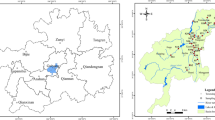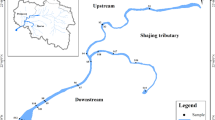Abstract
In this study, nutrient and heavy metal contamination in surface sediments of the Xiashan stream were investigated. Determining pollution degree of nutrient and heavy metal were the main objectives of this investigation. For this reason, the concentrations of total nitrogen (TN), total phosphorus (TP), seven heavy metals (Cu, Zn, Pb, Cd, Cr, Ni, Hg), and metalloid (As) were analyzed at 55 sampling sites. The mean TN concentration in surface sediments was 5.007 g/kg, while the mean TP concentration was 0.385 g/kg. Based on the sediment quality guideline (SQGs) and background values of Chinese soil and sediment, the majority of the mean TN concentrations in surface sediments were higher than their background values, while the TP concentrations were different from those observed for TN. For heavy metal concentrations in surface sediments, most of sampling stations were higher than their background values. The mean geo-accumulation (Igeo) indices for heavy metals were ranked as follows: Cd > Hg > Cu > Zn > Pb > Ni > Cr > As. The potential ecological risk index (RI) indicated heavy metal contamination level in Xiashan stream was very high ecological risk. According to Igeo and RI values, heavy metals especially Cd and Hg are influenced significantly by anthropogenic activities. Cd and Hg are not only as pollutant but also considerable contributor to ecological risk. Multivariate statistical investigations showed that there is a significant and positive correlation between Pb, As, and Cd. Cu, Ni, and Cr have similar characteristic and therefore probably originated from the same sources. Suggested by the results, it is necessary to control nitrogen and heavy metal contamination caused by human activities in the study area.








Similar content being viewed by others
References
Accornero A, Gnerre R, Manfra L (2008) Sediment concentrations of trace metals in the Berre lagoon (France): an assessment of contamination. Arch Environ Contam Toxicol 54(3):372–385
Ahlgren J, Reitzel K, De BH, Gogoll A, Rydin E (2011) Release of organic P forms from lake sediments. Water Res 45(2):565–572
Calmano W, Ahlf W, Förstner U (1990): exchange of heavy metals between sediment components and water, Metal Spec Environ, pp. 503-522
Carman ICC, Li XD, Zhang G, Wai WO, Li SY (2007) Trace metal distribution in sediments of the Pearl River Estuary and the surrounding coastal area, South China. Environ Pollut 147(2):311–323
Carpenter SR (2005) Eutrophication of aquatic ecosystems: bistability and soil phosphorus. Proc Natl Acad Sci U S A 102(29):10002–10005
Chen HZ, Wang JG, Chen JM, Lin H, Lin C (2016) Assessment of heavy metal contamination in the surface sediments: a reexamination into the offshore environment in China. Mar Pollut Bull 113(1-2):132–140
Chi QH, Yan MC (2007) Handbook of elemental abundance for applied geochemistry. Geological Publishing House, Beijing (in Chinese)
Dai LJ, Wang LQ, Li LF, Liang T, Zhang YY, Ma CX, Xing BS (2018) Multivariate geostatistical analysis and source identification of heavy metals in the sediment of Poyang Lake in China. Sci Total Environ 621:1433–1444
Duodu GO, Goonetilleke A, Ayoko GA (2017) Potential bioavailability assessment, source apportionment and ecological risk of heavy metals in the sediment of Brisbane River estuary, Australia. Mar Pollut Bull 117(1-2):523–531
Fujita M, Ide Y, Sato D, Kench PS, Kuwahara Y, Yokoki H, Kayanne H (2014) Heavy metal contamination of coastal lagoon sediments: Fongafale Islet, Funafuti Atoll, Tuvalu. Chemosphere 95:628–634
Gaur VK, Gupta SK, Pandey SD, Gopal K, Misra V (2005) Distribution of heavy metals in sediment and water of river Gomti. Environmental Monitoring and Assessment 102(1-3):419–433
Ghrefat H, Yusuf N (2006) Assessing Mn, Fe, Cu, Zn, and Cd pollution in bottom sediments of Wadi Al-Arab Dam, Jordan. Chemosphere 65:2114–2121
Hakanson L (1980) An ecological risk index for aquatic pollution control.a sedimentological approach. Water Res 14:975–1001
Hu JF, Peng PA, Jia GD, Mai BX, Zhang G (2006) Distribution and sources of organic carbon, nitrogen and their isotopes in sediments of the subtropical Pearl River estuary and adjacent shelf, Southern China. Marine Chemistry 98(2-4):274–285
Hussain R, Khattak SA, Shah MT, Ali L (2015) Multistatistical approaches for environmental geochemical assessment of pollutants in soils of Gadoon Amazai Industrial Estate, Pakistan. Journal of Soils and Sediments 15(5):1119–1129
Jamshidi-Zanjani A, Saeedi M (2013) Metal pollution assessment and multivariate analysis in sediment of Anzali international wetland. Environ Earth Sci 70(4):1791–1808
Kaiser HF, Rice J (1974) Little jiffy, mark IV. Edu Psychol Meas 34(1):111–117
Krzysztof L, Danuta W (2003) Application of principal component analysis for the estimation of source of heavy metal contamination in surface sediments from the Rybnik Reservoir. Chemosphere 51(8):723–733
Li L, Jiang M, Liu Y, Shen X (2019) Heavy metals inter-annual variability and distribution in the Yangtze River estuary sediment, China. Mar Pollut Bull 141:514–520
Liu M, Chen J, Sun X, Hu Z, Fan D (2019) Accumulation and transformation of heavy metals in surface sediments from the Yangtze River estuary to the East China Sea shelf. Environ Pollut 245:111–121
Liu XN, Tao Y, Zhou KY, Zhang QQ, Chen GY, Zhang XH (2017) Effect of water quality improvement on the remediation of river sediment due to the addition of calcium nitrate. Sci Total Environ 575:887–894
Luque-Espinar JA, Pardo-Igúzquiza E, Grima-Olmedo J, Grima-Olmedo C (2018) Multiscale analysis of the spatial variability of heavy metals and organic matter in soils and groundwater across Spain. Journal of Hydrology 561:348–371
Lv J, Liu Y, Zhang Z, Dai J (2013) Factorial kriging and stepwise regression approach to identify environmental factors influencing spatial multi-scale variability of heavy metals in soils. J Hazard Mater 261:387–397
Muller G (1969) Index of geoaccumulation in the sediments of the Rhine River. Geojournal 2:108–118
Munger ZW, Carey CC, Gerling AB, Hamre KD, Doubek JP, Klepatzki SD, McClure RP, Schreiber E (2016) Effectiveness of hypolimnetic oxygenation for preventing accumulation of Fe and Mn in a drinking water reservoir. Water Res 106:1–14
Ni ZK, Wang SR (2015) Historical accumulation and environmental risk of nitrogen and phosphorus in sediments of Erhai Lake, Southwest China. Ecol Eng 79:42–53
Paerl HW (1988) Nuisance phytoplankton blooms in coastal, estuarine, and inland waters. Limnol Oceanogr 33:823e847
Pan HY, Lu XW, Lei K (2017) A comprehensive analysis of heavy metals in urban road dust of Xi’an, China: contamination, source apportionment and spatial distribution. Sci Total Environ 609:1361–1369
Pejman A, Nabi BG, Ardestani M, Saeedi M, Baghvand A (2015) A new index for assessing heavy metals contamination in sediments: a case study. Ecol Indic 58:365–373
Persaud D, Jaagumagi R, Hayton A (1993) Guidelines for the protection and management of aquatic sediment quality in Ontario. Water Resources Branch. Ontario Ministry of the Environment, Toronto
Phil-Eze PO (2010) Variability of soil properties related to vegetation cover in a tropical rainforest landscape. J Geogr Reg Plann 3:177–184
Qiu JD, Liu JQ, Li MN, Wang S, Bai WM, Zhang DL (2018) Assessment of heavy metal contamination in surface sediments from the nearshore zone, southern Jiangsu Province, China. Mar Pollut Bull 133:281–288
Ramamoorthy S, Rust BR (1978) Heavy metal exchange processes in sediment-water systems. Environ Geol 2(3):165–172
Ranjbar JA, Riyahi BA, Shadmehri TA, Jadot C (2017) Spatial distribution, ecological and health risk assessment of heavy metals in marine surface sediments and coastal seawaters of fringing coral reefs of the Persian Gulf, Iran. Chemosphere 185:1090–1111
Rothwell JJ, Evans MG, Allott TEH (2006) Sediment–water interactions in an eroded and heavy metal contaminated peatland catchment, Southern Pennines, UK. Water Air Soil Poll 6(5-6):669–676
Saddik M, Fadili A, Makan A (2019) Assessment of heavy metal contamination in surface sediments along the Mediterranean coast of Morocco. Environ Monit Assess 191(3):197
Smith VH, Tilman GD, Nekola JC (1999): Eutrophication: impacts of excess nutrient inputs on freshwater, marine, and terrestrial ecosystems. Environ Pollut 100: 179 ± 196
Song YX, Ji JF, Yang Z, Yuan XY, Mao CP, Frost RL, Ayoko GA (2011) Geochemical behavior assessment and apportionment of heavy metal contaminants in the bottom sediments of lower reach of Changjiang River. Catena 85(1):73–81
Stoffers P, Glasby GP, Wilson CJ, Davis KR, Watter P (1986) Heavy metal pollution in Wellington Harbour. New Zeal J of Mar Fresh 20:495–512
Tchounwou PB, Yedjou CG, Patlolla AK, Sutton DJ (2012) Heavy metal toxicity and the environment. Exp Suppl 101:133–164
Varol M (2011) Assessment of heavy metal contamination in sediments of the Tigris River (Turkey) using pollution indices and multivariate statistical techniques. J Hazard Mater 195:355–364
Wang C, Liu S, Zhao Q, Deng L, Dong S (2012) Spatial variation and contamination assessment of heavy metals in sediments in the Manwan Reservoir, Lancang River. Ecotoxicol Environ Saf 82:32–39
Wang S, Lai ZN, Yang WL, Pang SX, Gao Y (2009): Distribution of organic nitrogen and total nitrogen in the surface sediments of Pearl River estuaries. J Anhui Agric Sci 37: 9081-9083(in Chinese)
Withers PJA, Jarvie HP (2008) Delivery and cycling of phosphorus in rivers: a review. Sci Total Environ 400:379–395
Wu TF, Qin BQ, Brookes JD, Yan WM, Ji XY, Feng J (2019) Spatial distribution of sediment nitrogen and phosphorus in Lake Taihu from a hydrodynamics-induced transport perspective. Sci Total Environ 650:1554–1565
Yang Y, Gao B, Hao H, Zhou HD, Lu J (2017) Nitrogen and phosphorus in sediments in China: a national-scale assessment and review. Sci Total Environ 576(15):840–849
Ye X, Wang AJ, Chen J (2014) Distribution and deposition characteristics of carbon and nitrogen in sediments in a semi-closed bay area, southeast China. Cont Shelf Res 90:133–141
Yin H, Wang J, Zhang R, Tang W (2019) Performance of physical and chemical methods in the co-reduction of internal phosphorus and nitrogen loading from the sediment of a black odorous river. Sci Total Environ 663:68–77
Yu JH, Ding SM, Zhong JC, Fan CX, Chen QW, Yin HB, Zhang L, Zhang YL (2017) Evaluation of simulated dredging to control internal phosphorus release fromsediments: focused on phosphorus transfer and resupply across the sediment-water interface. Sci Total Environ 592:662–673
Yue WZ, Huang XP, Sun CC (2007) Distribution and pollution of nitrogen and phosphorus in surface sediments from the Pearl River Estuary. Oceanologia Et Limnologia Sinica 38:111–117 (in Chinese)
Zhang H, Shan B (2008) Historical records of heavy metal accumulation in sediments and the relationship with agricultural intensification in the Yangtze-Huaihe region, China. Sci Total Environ 399(1-3):113–120
Zhao YF, Xu M, Liu Q, Wang ZF, Zhao L, Chen Y (2018) Study of heavy metal pollution, ecological risk and source apportionment in the surface water and sediments of the Jiangsu coastal region, China: a case study of the Sheyang Estuary. Mar Pollut Bull 137:601–609
Zhu MY, Zhu GW, Li W, Zhang YL, Zhao LL, Gu Z (2013a) Estimation of the algal-available phosphorus pool in sediments of a large, shallow eutrophic lake (Taihu, China) using profiled SMT fractional analysis. Environ Pollut 173:216–223
Zhu X, Ji H, Chen Y, Qiao M, Tang L (2013b) Assessment and sources of heavy metals in surface sediments of Miyun Reservoir, Beijing. Environ Monit Assess 185(7):6049–6062
Zrelli RE, Courjault-Rade P, Rabaoui L, Castet S, Michel S, Bejaoui N (2015) Heavy metal contamination and ecological risk assessment in the surface sediments of the coastal area surrounding the industrial complex of Gabes city, Gulf of Gabes, SE Tunisia. Mar Pollut Bull 101(2):922–929
Funding
This work was supported by the Science and Technology Planning Project of Guangdong Province, China (2019B110205003), Open Research Fund of State Key Laboratory of Estuarine and Coastal Research (Grant number SKLEC-KF201613), Major Science and Technology Program for Water Pollution Control and Treatment (2017ZX07301006004), Environmental Protection Foundation of Guangdong (PM-zx555-201809-198).
Author information
Authors and Affiliations
Corresponding author
Additional information
Responsible editor: Céline Guéguen
Publisher’s note
Springer Nature remains neutral with regard to jurisdictional claims in published maps and institutional affiliations.
Rights and permissions
About this article
Cite this article
Li, W., Lin, S., Wang, W. et al. Assessment of nutrient and heavy metal contamination in surface sediments of the Xiashan stream, eastern Guangdong Province, China. Environ Sci Pollut Res 27, 25908–25924 (2020). https://doi.org/10.1007/s11356-019-06912-2
Received:
Accepted:
Published:
Issue Date:
DOI: https://doi.org/10.1007/s11356-019-06912-2




